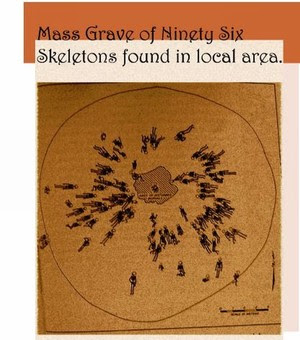
Many years ago in Cape Canaveral, a mass grave of 96 skeletons was found. A strange arrangement as the skeletons were arranged as spokes in a wheel with their heads pointed towards the apex of the mound. Among the skeletons discovered were interesting artifacts including a crystal necklace.
Such were the findings of a 1933-34 archeological expedition to the Cape Canaveral and Indian River areas. A Dr. George Woodbury under the direction of the Smithsonian's Bureau of Ethnology director Dr. Stirling, investigated burial mounds among a series of six mounds in the Artesia area of Cape Canaveral. The dig sites he researched revealed a culture of Native Americans that lived at the Cape 3,000 years ago, other researchers believed they may as old as 8,000 to 10,00 years old. This burial mound was one among six others in the Artesia area of Cape Canaveral that revealed other interesting artifacts.
Could these mounds be signs of the ancient Indian village of "Savochequueya" from the Ais Indians that lived in the area of Cape Canaveral? If not a city perhaps a large town or village. A Florida archaeological survey from the Bureau of Archaeological Review stated of the Fuller Mound. "One of a string of burial mounds (90-95) all making up a complex village site. This is the largest"
The human remains examined at the site consisted of 35 adult males, 42 adult females, 7 adults of uncertain sex and twelve infant skeletons. Artifacts found in their grave included 1 bone whistle, 1 shell bead, iron celt and 2 pendants. Other artifacts described by another anthropologist Irving Rouse from Yale University in his 1951 publication are a bowl and quartz crystal pennant. Rouse describes in his writings. "one of the St. Johns Plains specimens is almost complete bowl, 4.5 inches in diameter. A notched stone weight two single grooved, plumment shaped pendants of quartz crystal,fragments of four bone pins, one peg topped and one slotted, three being engraved. Then further south, to the Burns mounds another interesting artifact surfaced that indicated an advanced Indian civilization evident of their trade, an artifact of a copper snake was discovered. Described by Rouse, in 1954, "a thin strip of metal, 13cms long and 17cms. wide (of aboriginal manufacture, but of European-transported metal). The tail portion has been cut out to represent (see pic next page) rattles while the body is decorated in a repousse technique. A row of fine close-spaced dots borders each edge of the body. On the body of the snake are marks arranged in panels set off by horizontal bars. This kind of stylized representation of the rattlesnake - by the use of x-marks on the body-is typical of South Cult forms".
How did these Indians get copper? Since there were no natural veins of copper ore in the area, maybe they traded with the northern Indians the Timucuans. Perhaps they obtained the copper from Europeans and then cold hammered it into their own shapes and ornaments. There are a number of theories.
Who were these early Cape Canaveral residents and how did they live? M.W. Stirling reported that the deceased were tall people of robust physique, the crania being large, under-formed, and uncommonly thick; the long bones, heavy and massive." Many myths referred to them as being giants. (1)
Spanish explorers in the 17th century called the local Indian River natives of their time period as Ays Indians. A Spanish explorer and military cartographer by the name of Alvaro Mexia mapped and befriended the Indians on neighboring Merritt Island. Nowadays we use the word Ais instead of Ays pronounced (Aice). It was a harsh environment when the Indians lived at Cape Canaveral. This area named by Europeans as Cape of Cane Fields. Swamps, scrub mangrove trees
and wild cane fields stretched as far as the eye could see and the land was only 15 or 20 feet above sea level. Alligators and crocodiles basked in the sun waiting to gobble up their next meal. Wild beasts
routed through the canes and swarms of gulls screeched endlessly overhead.
Further evidence of a village may be considered in that there was a find of a circle in the area. The BAR master file states that a 20 foot circular area making up an Indian Wall was discovered. The reader may want to compare it with the Miami circle and other American earthworks.
(1) Giants? "Indians were not especially tall." said David Dickle of the Fl. Bureau of Archaeological Research Collections and Conservation Lab. "The reverse however is true- that is, Europeans of the time were generally short due to poor childhood diets (especially protein deficient) and childhood biological stress in general. The contrast was especially obvious to early Spanish and French sailors, who often came from lower economic classes and thus subject to more childhood stress. Thus Native Americans were not especially tall (6 foot would be a tall person), but many Europeans were short (5' 6" would be a tall person). The Europeans, being ethnocentric, instead of wondering why they were so short compared to Indians, instead wondered why the Indians were tall. Thus the story of extra-large Indians started. The guy looking up thinks the other guy is tall- the guy looking down thinks the other guy is short."
2) This was not the first time skeletons were found in this arrangement. "Boston Daily Globe April 24,1873 reported in their story entitled. "Indian Mounds in Florida- Burnham's Grove of Orange tree - Remains of a Giant Race- Curious Potter Recovered" "Sir Francis Sykes a British nobleman visited Cape Canaveral by Captain Burnham’s permission he excavated the mound, and took out twenty-seven complete skeletons. The skeletons were found lying side by side in a circle, with their heads towards the centre of the mound."
A geocache called Ais Indian Nation marks the location of where these mounds were once.
To be continued.

No comments:
Post a Comment